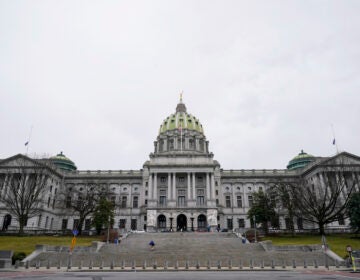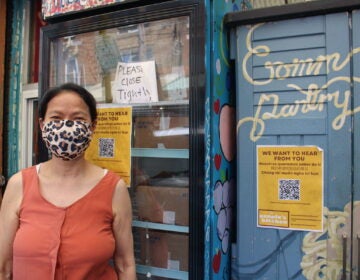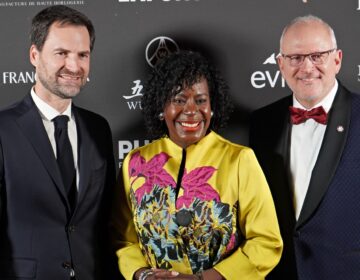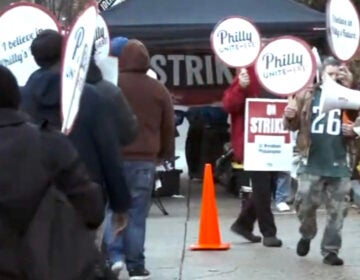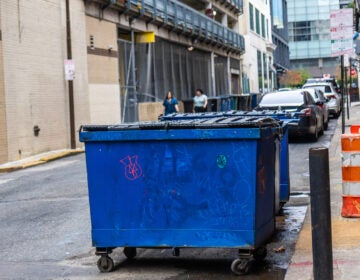Philly’s Center City restaurants hope for a boost as remote work wanes
As commuters return to in-person work, here’s how local restaurants are working to adapt to what customers want now.
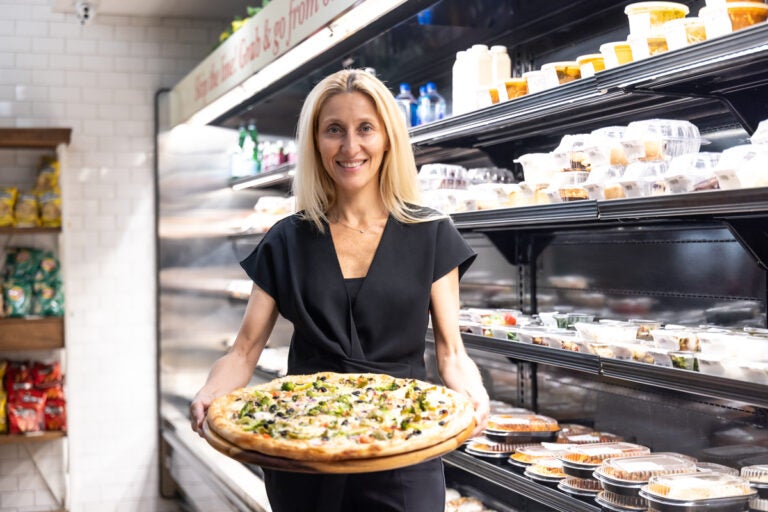
Rosita Lamberti, director of restaurants for the Aldo Lamberti family of restaurants, holds a pizza inside Lamberti’s at 7th and Chestnut in Center City, Philadelphia. (Kimberly Paynter/WHYY)
From Philly and the Pa. suburbs to South Jersey and Delaware, what would you like WHYY News to cover? Let us know!
Lamberti Pizza & Market is just one of nearly 500 brick-and-mortar restaurants across Center City eager for a slice of hungry customers.
And like many downtown businesses, the family-owned restaurant near 7th and Chestnut streets relies on commuters to stay afloat.
Rosita Lamberti, director of restaurants for the Aldo Lamberti Family of Restaurants, said she remembers shutting down then-Lamberti’s Pizza Fresca four years ago during the height of the COVID-19 pandemic in Center City.
“There was nobody working in the city, we just weren’t able to stay open,” Lamberti said about the situation in June 2020.
Instead of simply reopening, the company decided to pivot its business model to sell more prepared meals like grilled chicken, salmon, roast beef and pulled pork.
In April 2021, the restaurant group opened the Lamberti Pizza & Market as a new concept, with gourmet pizza and prepared foods for a commuter to pick up as dinner on their way home.
“We kind of switched gears,” she said. “We have entrees that are ready-to-go and we’re always adding things. The whole idea was to make life easier.”
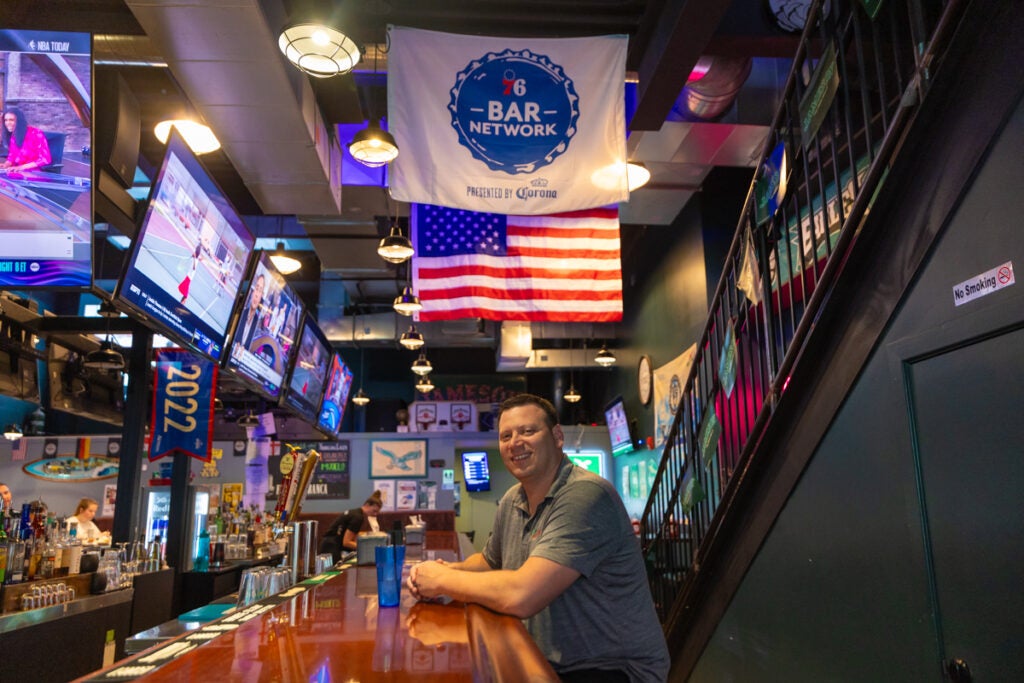
Now as more Center City employees are working hybrid schedules, the market’s busiest days are Tuesdays, Wednesdays and Thursdays.
“People who work in the city are the guests who drive our business,” she said.
There’s less demand on Mondays and Fridays during the lunch rush, then a bump from tourism on Saturdays, she said. There are more than 100 workers at the company, with about a dozen at the Center City location.
Lamberti is offering discounts to hospital and city office workers for the rest of the year as one way to “bring some joy” as they return to on-site work. In mid-July, when thousands of city workers were mandated back into the office five days a week, there was a slight bump in sales and noticeably more foot traffic.
“I definitely felt like there were more people in the city, more people walking around,” she said.
Foot traffic bouncing back
In June, there were more than 378,400 pedestrians walking around Center City Philadelphia, which is down 1% year over year, according to anonymized cell phone data tracked by Center City District. June foot traffic was at 86% of 2019 levels. Data for July is expected to be released in August.
Inside that overall figure: about 94,500 pedestrians are commuters to Center City, more than 67,600 are residents and 220,200 are visitors. Commuter foot traffic is roughly 60% of what it was in 2019.
In February, Mayor Cherelle Parker promised the Chamber of Commerce for Greater Philadelphia that she would bring all 26,000 city workers back to in-person work to boost the economy. In exchange, Parker praised private sector employers willing to do the same and asked for more to make that switch from remote to hybrid and in-person.
One effect of the shift to remote work is that Philadelphia’s commuter wage tax base has shrunk. More than $94 million was refunded to employees of companies working remotely in the suburbs in 2021. Another $85 million was refunded to those workers from city wage taxes in 2022. It was not immediately clear how much of the wage tax was refunded by the city in 2023.
During the height of the COVID-19 pandemic, researchers were concerned about the concept of an “urban doom loop” in cities.
The fear was that a significant loss of city revenue from remote workers, whether from the city wage tax or sales taxes, would lead to a strain in city services. That would further deteriorate the quality of life, shrink the tax base and lead to a downward spiral. But that’s not what happened.
“The [urban] doom loop is not inevitable,” said Tracy Hadden Loh, a fellow with the Brookings Institute who specializes in commercial real estate. “It is still possible for Philadelphia and other major U.S. cities to emerge from the pandemic in a resilient way.”
For example, Philadelphia is already outpacing its peer cities in developing residential neighborhoods downtown and within a few miles of the urban core, she said.
But that doesn’t mean there aren’t still major hurdles. It’s difficult to change a city with big downtown office skyscrapers, retailers and a transit system that’s overwhelmingly positioned to serve commuters.
“Their lack of agility is something that can drag down the entire regional economy,” Hadden Loh said. “If people can’t find office spaces in the best locations that are the most innovative, we waste the public infrastructure supporting these locations. Then that’s a drag on everybody, not just the building owners.”
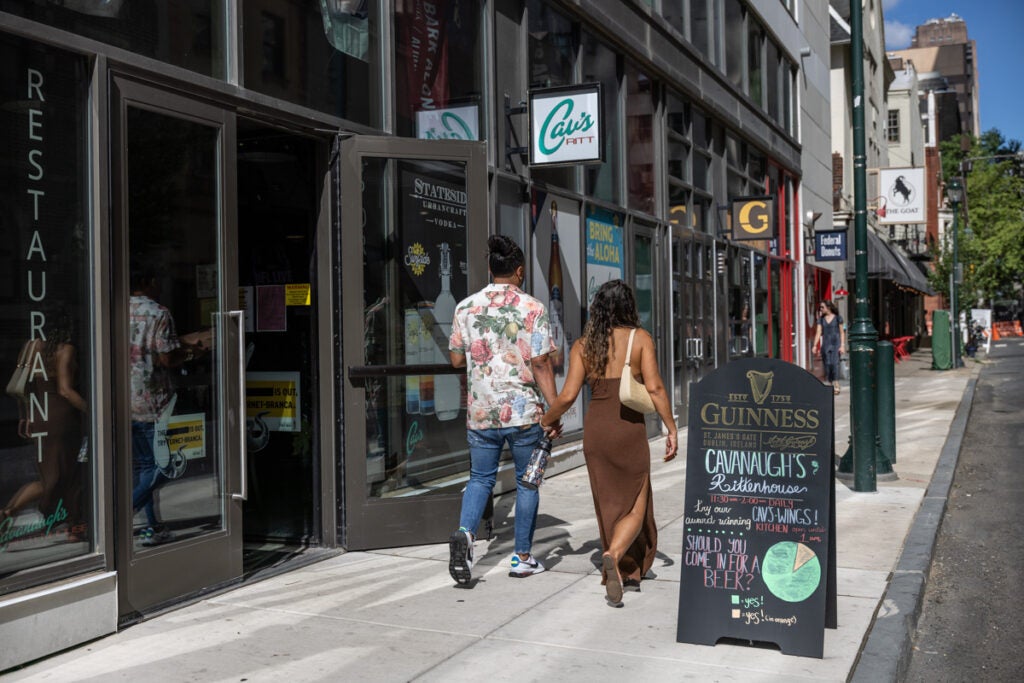
And yet, the researcher did not recommend eliminating remote work for municipal office jobs but instead suggests it’s a better use of taxpayer money to reduce the city’s office footprint.
“The public sector is under unique pressure to save money and reduce overhead,” she said. “What we actually recommend is right-sizing government office buildings and disposing of underutilized land and buildings, making that available for private development.”
Changing at-work patterns
Two years ago, Center City restaurant and bar Cavanaugh’s Rittenhouse decided to double down on its brick-and-mortar footprint. It renovated 4,000 square feet over two levels for its expanded location and employs 45 people. The cost of labor went up from at least $15 an hour to $19 an hour for cooks, he said.
Office worker foot traffic is key to its survival. But the lunch rush has changed, said general manager Mike Anderson.
He’s noticed customers are more likely to order delivery to eat at their desk or at their home office.
“It really seems like people are working through their lunch more than ever or not everyone has gone back to working in an office every day,” Anderson said.
There’s also much more competition for restaurants in neighborhoods across the city that didn’t exist a decade ago.
Now Thursdays are the busiest night of the work week, in part because that’s when corporate offices are most likely to have workers commute into the city for after-work happy hours.
“The boss will bring in a group of like 25 [people] whatever section of the office that is and they’ll have a happy hour that the company is sponsoring,” he said.
Center City SIPS on Wednesdays does give the bar a bump, but Anderson said he’s noticed the crowd isn’t early career professionals. Rather, it is starting to skew towards college students.
The bar didn’t see a rush of city workers since the return-to-office mandate, despite offering specials. But he suggested that might be because of its distance from city offices.
Center City’s growing residential population is one bright spot, he said.
“I’m optimistic and hopeful that those kinds of things will continue to grow and Center City will become more like a traditional neighborhood where I live, work and hang out there,” he said.

Get daily updates from WHYY News!
WHYY is your source for fact-based, in-depth journalism and information. As a nonprofit organization, we rely on financial support from readers like you. Please give today.

